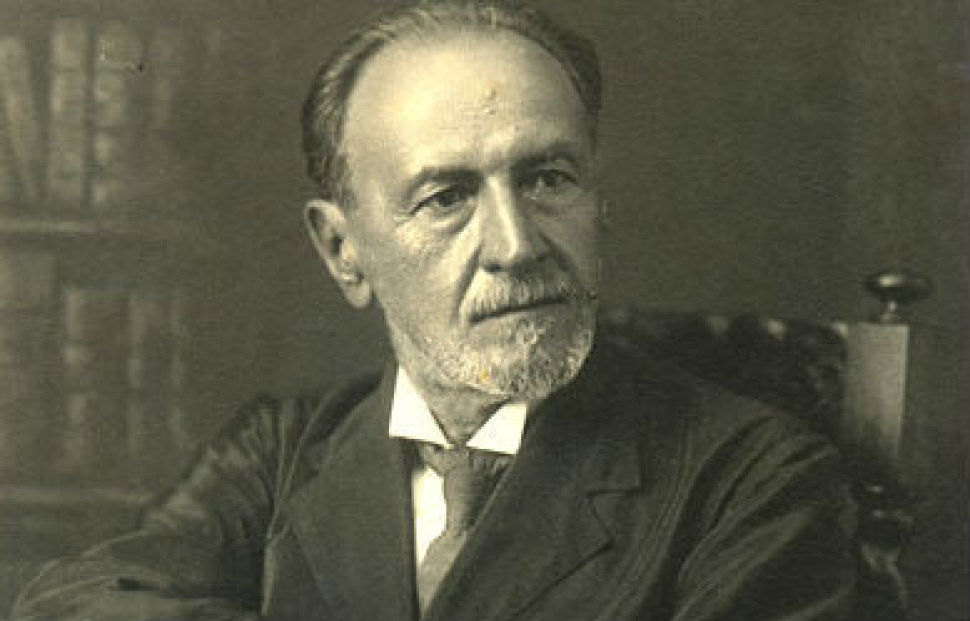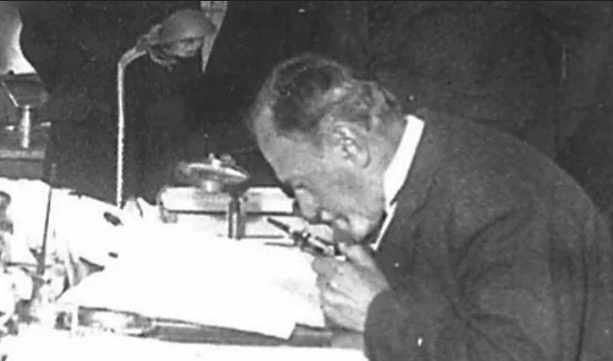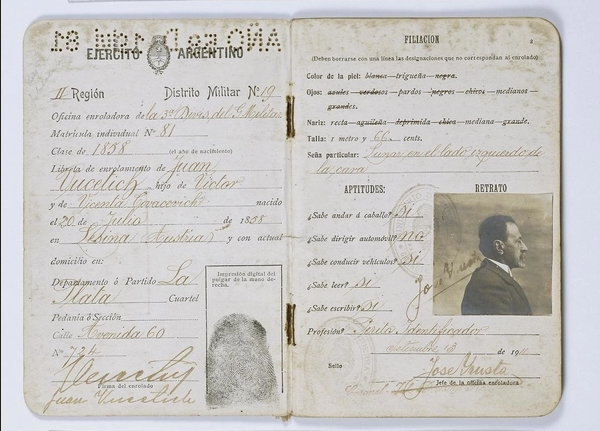
Ivan Vučetić (1858-1925), father of modern CSI – the creator of the modern method of dactyloscopy – the discipline of criminal techniques, one of the safest and most common methods of identifying persons, based on the papillary lines on the fingers, palms and feet of people.
Born at Hvar in the Dalmatian region of Croatia then part of the Habsburg Monarchy, he was the oldest of eleven children and learned to become a cooper to inherit his fathers trade.
On Hvar, Vučetić attended a school led by Minorite Bonagracije Marojević, where he learned to read and write German and Italian and also gained a musical education. This enabled him to get acquainted with the world-famous scientists who visited Hvar and gained an education in humanistic and natural sciences. In Pula, where he served in the Austro-Hungarian Navy he led a military orchestra. He was also a chaplain of the music of Hvar.
Being restless and free-spirited at the age of 24, he immigrated to Argentina and adopted the Spanish translation of his Croatian name Juan Vucetich.
Although having only elementary school education, his literacy brought him to work at the Argentinian Sanitary Service for six years until he was appointed as an honorary consultant at the Headquarters of the Police Department Office of Identification and Statistics in the capital of Buenos Aires, La Plata. Ivan Vučetić - Sherlock Holmes From Hvar
Ivan Vučetić -Sherlock Holmes

Vučetić was placed in charge of the anthropometric method used at the time to identify criminals based on bodily measurements. After reading an article in a French journal on Francis Galton’s experiments with fingerprints as a means of identification, Vučetić began collecting fingerprints, taken from arrested men. Galton’s initial study proposed parameters to classify fingerprints, but no system to collect or identify the individual using only this method.
The fingerprints as a marker of individuality and uniqueness of a human being are said to have been discovered by Herschel in 1877., further investigated by Galton in 1886., and organized in a more systematic fashion by Henride. But it was Vučetić who introduced the use of fingerprinting as an indispensable method for identifying people in police work and wherever else positive identification of an individual is used.

Ivan Vučetić (1858-1925), father of modern CSI – the creator of the modern method of dactyloscopy – the discipline of criminal techniques and how useful this would be in police work and criminology. He created and constructed tools to take fingerprints in a standardized fashion we know today – the dactyloscopy table consisting of a marble board with extended ink, a zinc plate to ink the fingers, a roll, and a wooden grooved board where the fingerprints were taken.
These original tools are still kept as models in a museum, and they represent the basis of a template for similar constructions almost all over the world.
This useable system to group and classify fingerprints, Vučetić called “Ichnophalangometrics” (description of phalangeal measurements), later named dactyloscopy.
Vučetić became famous after demonstrating the utility of fingerprint evidence in 1892. case in the monstrous crime of Francisca Rojas who murdered her own children and then cut her own throat, trying to put the blame on the outside attacker. She accused her lover of committing the murder. Vučetić compared hers and the bloody print left on the door and discovered Francisca Rojas was the killer and her lover was found innocent. In the end, the woman confessed and got convicted of a suspect for first-degree murder.
It was the first known case in the world solved by method Vučetić used. Afterwards, two more cases were solved proving the methods accuracy.

In 1900., the Argentine Republic began issuing internal passport that included fingerprints – a practice that was eventually adopted by many other countries. 1904. publication of “Dactiloscopia Comparada”, Vučetić’s definitive work on fingerprint identification, and his travels to China, India and other countries in order to attend scientific conferences to gather more data, helped to spread his system throughout the world.
In 1905, he founded the Drop of Milk Association, which enabled the support for children whose parents were police officers killed in the service. The association eventually became a humanitarian foundation for all orphaned children. As Vučetić loved music, played great piano and composed, he also founded 1900. police orchestra.
At age 52, he received a Diploma of Identity Expert, whose name he himself suggested to the Province of Buenos Aires. He was a member of the French Academy and the Institute of Anthropology in Paris. The dactyloscopy made Vučetić and Argentina famous around the world. Professor Enrico Ferri, the most famous Italian criminologist and founder of criminal sociology, visited the city of La Plata in 1908. and wrote in the visitors’ books of the Office of Identification: I am happy to find myself in a place where the pursuit of a genius process continues and I am even more pleased to find the initiator of the most important characteristics of this process here – friend Vučetić.

As part of his world tour in 1913, Ivan Vučetić visited his native Hvar. On this occasion, he donated a copy of his famous book “Dactiloscopia Comparada” with the following dedication: “With due respect to the town of my beloved homeland”.
In 1914., the Chinese government was impressed by the fact that Vučetić established and organized an identification service in Beijing. The University of Judicial Medicine of Madrid proclaimed Vučetić an honorary professor and later that year he became a member of the International Identity Association in Washington. In the end, the Argentine Congress granted him a special government pension for extraordinary merit in the field of science.
Vučetić also introduced the subject of “Identification” to the curriculum for law students in Argentina, and in 1923. the Police Museum Juan Vucetich opened in La Plata. He died in 1925. at 67 years of stomach cancer. He was married three times, two of which left a widower. He left five children behind.
His second homeland Argentine repaid his accomplishments by a series of books and monographs about him and his scientific opus, issuing a postage stamp with his character and numerous memorial features. In his honour, the Buenos Aires province police academy, near La Plata, has been named Escuela de Policía “Juan Vucetich” (Juan Vucetich Police Academy).
Famous German criminologist, Dr Robert Heindl, told about Vučetić: He had only primary school. Nevertheless, he possessed a strong mathematical-statistical retention, a fiery enthusiasm for new science and the immaculate vitality of the peasant boy. Vučetić was a very imaginative propagator of his system and his ideas regarding the entirely new role of police in Argentina and the world that sought after to develop a broad and versatile social struggle against crime.
The police Centre for Forensics Examinations (Centar za kriminalisticka vjetacenja “Ivan Vučetić”) in Zagreb, Croatia is named after him. In their DNA database (CODIS), there are currently over 27,000 DNA profiles stored. All these are profiles of suspects for criminal offenses. As known, the DNA expertise results are evidence for the court and account for 90 percent of the cases. This Centre also does expertise for more than 500 pieces of fire, air, gas and other weapons per year. There are 2600 pieces of various weapons stored in work collections to help with identification.
Facts about Ivan Vučetić:
Vučetić was also a composer and played clarinet very well. When he was young, he was the leader of Hvarska gradska glazba (Hvar City Music).
Ivan Vučetić traveled to Argentina by boat from Trieste as a hidden passenger without documents. He hid in a coal room to not be detected.
Before working for the police in La Plata, he worked in a state company for public sewage and wastewater.
A police museum and a neighborhood in La Plata as well as a school in Rosario, Argentina were all named after him.
The city park in Hvar is adorned with a bust of Ivan Vučetić created by Croatian sculptor Joakim Jaki Gregov and floor mosaic “Otisak prsta” (a fingerprint) created by Tonka Alujević.
Vučetić always left a fingerprint of his right index finger together with his signature.
He spoke four foreign languages: Italian, German, Spanish, and French. He was married three times and had five children (four daughters and a son).
Comments